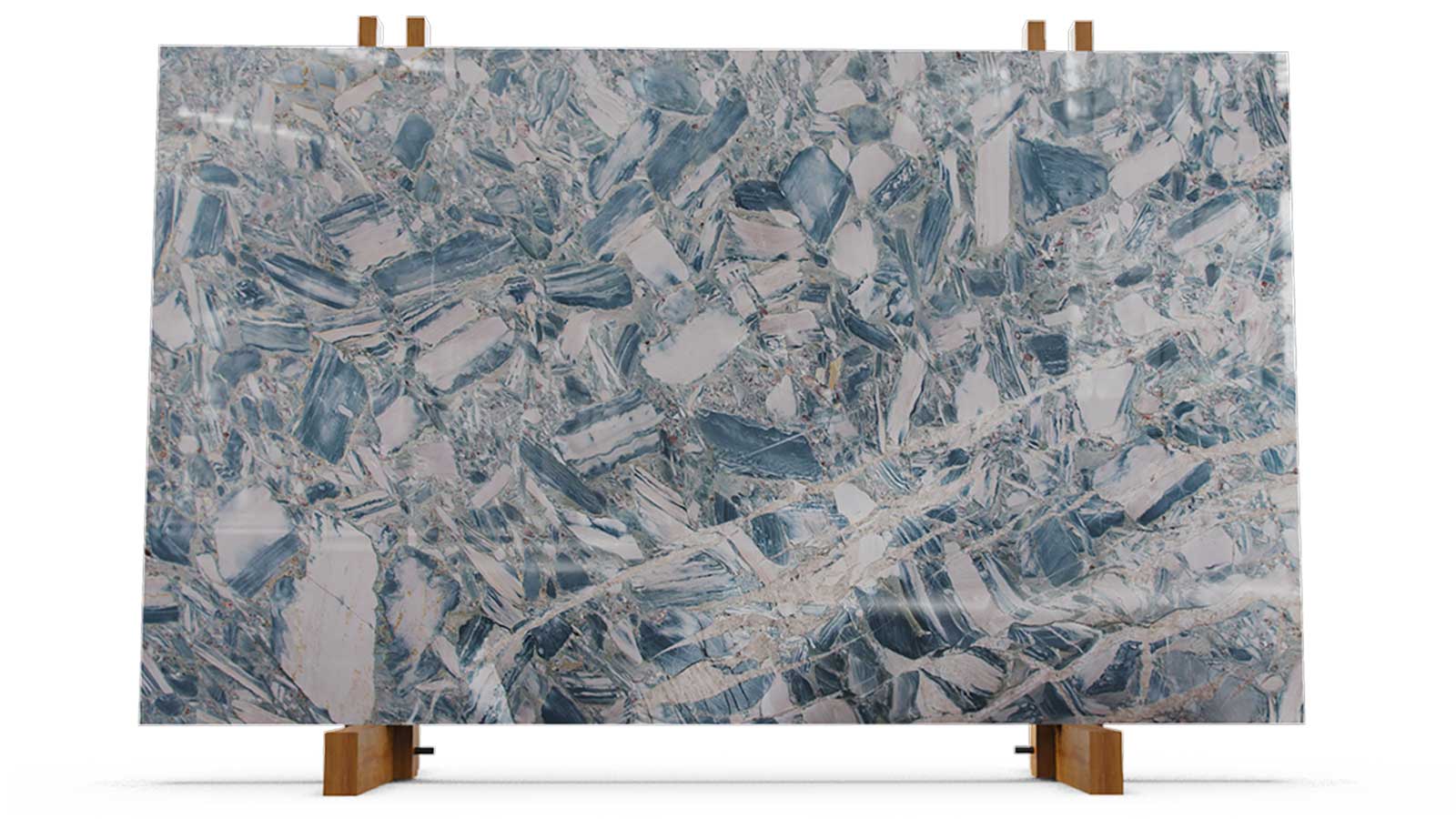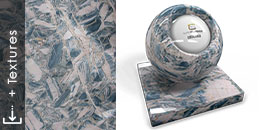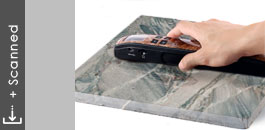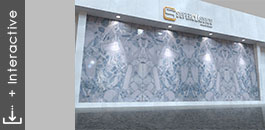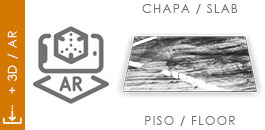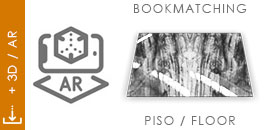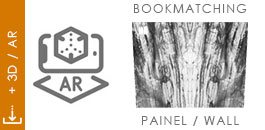Cocadablú – Exotic Brazilian Natural Quartzite
Cocadablú is an exotic Brazilian natural stone, distinguished by its unique appearance and superior physical properties. Classified as a tectonic breccia/quartzite, Cocadablú is predominantly composed of quartz, with veins and inclusions formed during the tectonic process. This unique formation gives Cocadablú a singular aesthetic, with varied patterns and a color palette that includes shades of blue, white, and gray. Each block of Cocadablú is a natural work of art, ensuring that any application of this stone becomes a visual highlight.
Characteristics
Composition
Cocadablú’s composition is dominated by quartz, one of the hardest minerals found in the Earth’s crust. The presence of quartz not only increases Cocadablú’s durability but also contributes to its resistance to scratches and abrasions, making it an ideal choice for work surfaces and high-traffic areas. In addition to quartz, other mineral inclusions in Cocadablú add color and texture variation, resulting in visual patterns that are both complex and attractive.
Appearance
The appearance of Cocadablú is one of its most notable attributes. With a mix of colors ranging from soft to intense tones, Cocadablú can adapt to a wide range of design styles. The predominant shades of blue, white, and gray, combined with distinct veins and fragments, create an artistic look that can transform any space. The uniqueness of each block of Cocadablú means that no project will be the same, providing exclusivity and distinction.
Texture
The texture of Cocadablú can be adjusted according to the desired application. A polished surface offers a smooth and glossy finish that highlights the natural colors and patterns of the stone. This finish is ideal for applications where aesthetics and ease of cleaning are priorities, such as kitchen countertops and table tops. Alternatively, a more natural and rustic finish may be preferred for applications seeking a more organic and textured look, such as wall cladding and outdoor flooring.
Uses
Cocadablú is widely used in a variety of applications due to its physical and aesthetic characteristics.
Cladding
For cladding, Cocadablú is a popular choice for both interiors and exteriors. On external facades, Cocadablú’s durability and weather resistance ensure that the building not only has an impressive appearance but also maintains its structural integrity over time. Indoors, Cocadablú can be used to create feature walls, adding an element of luxury and sophistication that becomes the focal point of the space.
Flooring
For flooring, Cocadablú’s durability makes it ideal for high-traffic areas such as entrance halls, commercial areas, and public spaces. Its high resistance to wear ensures that Cocadablú flooring will retain its original appearance for many years, even with constant use. Additionally, the stone’s low porosity makes maintenance easy, making it a practical and aesthetically pleasing choice for flooring.
Countertops
For countertops, Cocadablú offers a combination of beauty and functionality. The polished surface provides an elegant appearance, while its resistance to wear and stains ensures that Cocadablú countertops can withstand daily use without losing their beauty. In kitchens, the hardness of the quartz in Cocadablú creates a scratch-resistant surface, ideal for food preparation and other culinary activities.
Decorative Elements
Cocadablú is also used in decorative elements such as tables, fireplaces, and other furniture pieces. The natural beauty of the stone stands out in any environment, adding a touch of exclusivity and sophistication. Furniture pieces made from Cocadablú can become the highlight of any space, combining functionality with an impressive aesthetic.
Extraction Locations
The southern region of Bahia is an important source of natural stones, including Cocadablú. The geology of the region favors the formation of high-quality and distinctively beautiful stones. The quarries operated by SuperClássico in this area ensure that the extracted Cocadablú meets the highest standards of quality, both in appearance and physical properties. The strategic location of these quarries allows for efficient and sustainable extraction of Cocadablú, ensuring that natural resources are used responsibly.
Care and Maintenance
To preserve Cocadablú’s beauty, it is essential to clean it regularly with water and neutral soap. Abrasive or acidic cleaning products should be avoided as they can damage the stone’s surface. Proper cleaning helps maintain Cocadablú’s shine and original appearance, ensuring it continues to impress for many years.
Applying a suitable sealant is recommended to protect the stone from stains and facilitate maintenance. Sealing creates a protective barrier on the stone’s surface, reducing liquid absorption and preventing stains. Regular sealant application can prolong Cocadablú’s lifespan and keep its appearance impeccable.
In case of damage, localized polishing and repairs can restore the stone’s original appearance. Specialized professionals can repair chips and scratches, ensuring Cocadablú maintains its integrity and beauty over time.
Installation
Cocadablú installation should be carried out by qualified professionals who ensure proper base preparation and adequate application of the stone. Fixing should be done with appropriate mortar and following recommended techniques to ensure the material’s durability and aesthetics. Correct installation is crucial to maximize Cocadablú’s lifespan and performance in any application.
Technical Analysis
Geological Classification
Cocadablú is classified as a tectonic breccia/quartzite. This geological classification highlights the stone’s unique formation process, contributing to its exceptional physical properties.
Strength
Cocadablú possesses high mechanical strength and durability, making it suitable for applications that require robust and long-lasting materials. Its ability to withstand pressure and impact is one of the reasons it is a popular choice for flooring and other surfaces subject to wear.
Porosity
Cocadablú’s low porosity reduces liquid absorption, facilitating maintenance and increasing its stain resistance. This characteristic is particularly important for applications in kitchens and bathrooms, where liquid exposure is frequent.
Hardness
Cocadablú’s high hardness, due to the predominance of quartz in its composition, ensures that the stone is resistant to scratches and other superficial damage. This property is essential for countertops and other work surfaces that face intensive daily use.
Historical Information
Cocadablú, like many exotic Brazilian natural stones, has gained popularity in the international design and architecture market. Its unique beauty and superior physical properties are highly valued by architects and designers worldwide. Cocadablú is frequently used in high-end projects where the combination of aesthetics and functionality is essential.
Conclusion
Cocadablú is an exceptional choice for those seeking a distinctive material with robust technical characteristics and striking aesthetics. Its physical properties, combined with its natural beauty, make it an ideal option for a wide range of design and architectural applications. From wall cladding to kitchen countertops, Cocadablú offers a durable and elegant solution for any project.
Cocadablú stands out for its versatility and ability to transform any environment, adding a touch of sophistication and exclusivity. Its durability, strength, and unique beauty ensure it is a superior choice for design and architectural projects, enhancing spaces and creating unique and inspiring environments.

Want to know more about this and other SuperClassico materials?
Ask your question to our AI here!
BookMatching
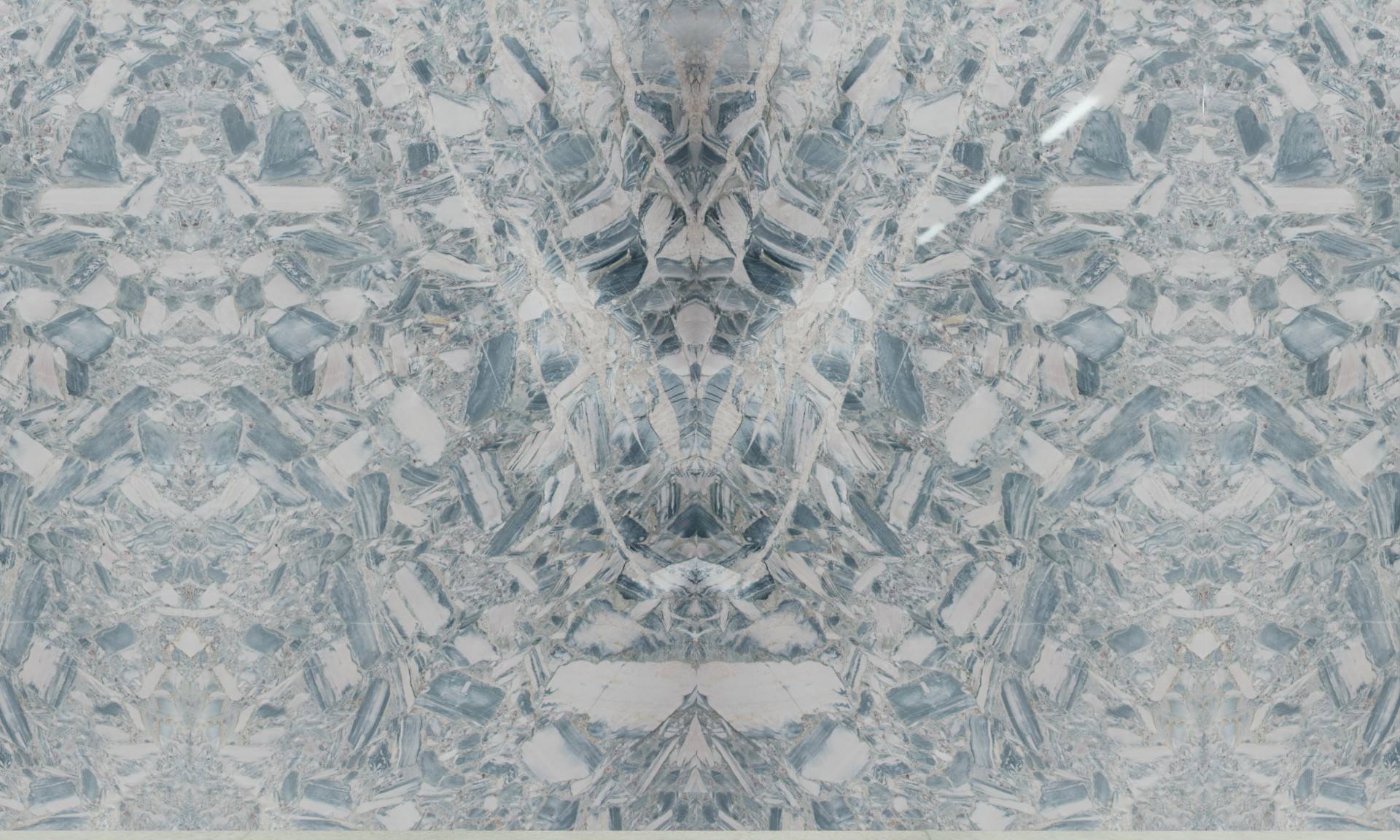 Vertical
Vertical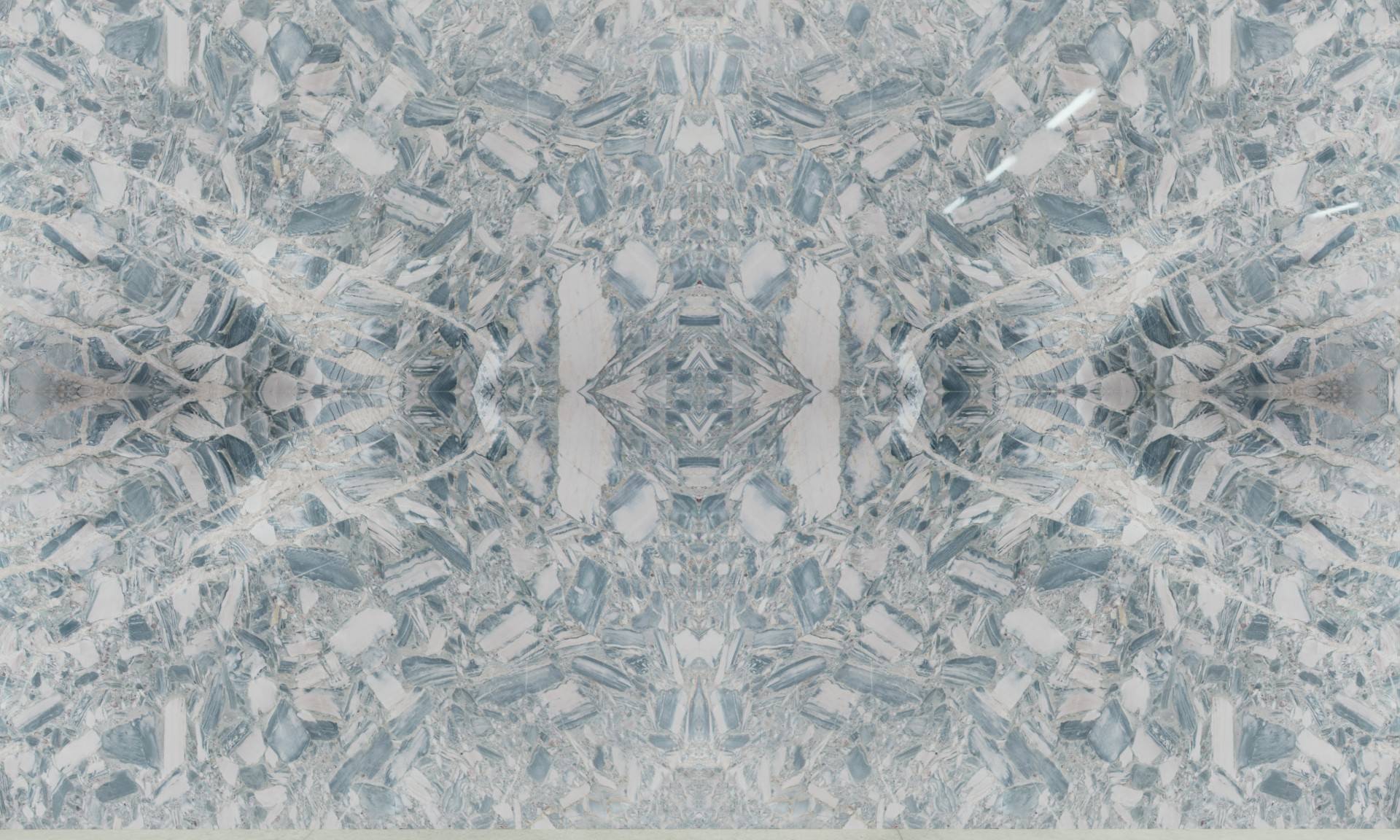 Horizontal
HorizontalFor Designers and Architects
Formed mainly by Quartz and Sericite minerals, with cyanite that gives the bluish coloration to this rock considered Tectonic Breccia.
| GEOLOGICAL CLASSIFICATION | QUARTZITE | ||
| TEST METHOD | NORMA | RESULTS | |
| Density | ABNT NBR15845-2:2015 | 2.658kg/m³ | |
| Porosity | ABNT NBR15845-2:2015 | 0,31% | |
| Water Absorption | ABNT NBR15845-2:2015 | 0,12% | |
| Hard Body Impact | ABNT NBR15845-8:2015 | 0,43m/4j | |
| Amsler Wear | ABNT NBR12042:2012 | (500m) 0,36mm (1000m) 1,84mm | |
| Bending Strength 4pts | ABNT NBR15845-7:2015 | 21,31 MPa dry 13,70 MPa saturated | |
| Uniaxial Compression | ABNT NBR15845-5:2015 | 159,17 MPa dry 141,33 MPa saturated | |
| Modulus of Rupture | ABNT NBR15845-6:2015 | 8,96 MPa dry 6,98 MPa saturated | |
| Freezing and Thawing | ABNT NBR15845-4:2015 | 0,98k | |
| Thermal Linear Expansion | ABNT NBR15845-3:2015 | 13,08×10-³mm/m0C | |
To simulate how a particular material would look as a floor, tabletop, or countertop in your home, use Augmented Reality technology on your smartphone. It’s easy! Just click on the “View in your space” button and you’ll be able to see the virtual object in your real environment. Try it now!
3D/AR View
Click on the CARDS below and choose different options to simulate the material with AR in your environment through your Smartphone’s camera.
Classification
Type: TECTONIC BRECCIA /QUARTZITE
About
One of the rarest and most exotic stones in the world, with its pastel tones of a blue background and light beige and gray formations, compose this mixture of bold colors of this magnificent material, which was formed in a fault for thousands of years called the tectonic breccia.
Composition
Surface Finishings
Polished
It is the “shiny” surface that results in the plate when receiving the complete finish, that is, until the last grain. Depending on its composition, the polished material may have a higher or lower brightness intensity.
Brushed
It is the resultant surface in the sheet when it receives roughing treatment performed by steel brushes or synthetic materials. Different brushing models can be executed, with greater roughness, medium and few.
Soft Leather
It is the resultant surface in the sheet when it receives roughing treatment performed by steel brushes or synthetic materials. Carried out with a brush of low roughness, which gives it a lightly textured look like fabric.
Flamed
It is the resultant surface in the plate when it receives heat treatment (burned with torch specially developed for the function) that takes out small flakes of the same, making the surface slightly irregular producing the impression that it is rustic.
Honed
It is the resultant surface on the sheet when receiving abrasive grinding wheels up to the grain 120. This grain defines the surface finish limit either as anti-slip or even for the application of resin and subsequent polishing.
Leather Finish
It is the resultant surface in the sheet when it receives roughing treatment performed by steel brushes or synthetic materials. Depending on the type of brushes used you can still reproduce in some materials a surface with a design similar to natural leather.

